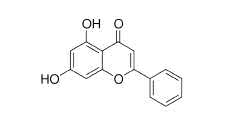The Benefits of Chyrsin Supplementation on your Natural Testosterone

Maximize Your Results by Optimize Daily Supplement Use
Men, listen up: You know your testosterone levels can affect how successful you are in putting on muscle and that the hormone
cycle in your body is pretty complex. Science has shown us several ways to subtly (and legally) alter the levels of
testosterone in your body, and one important compound in that process is something called chrysin.
Chrysin (5,7-dihydroxvflavone) is part of a group of chemicals known as flavones and isoflavones that inhibit the action of
the enzyme aromatase. Why is that important? Because aromatase is the enzyme that converts your ever-important androgens to
estrogens, or to put it another way, makes you a more feminine man. Theoretically if you could block this conversion, you'd
have less bioactive estrogen and perhaps more of what you want - testosterone. That could mean an improved physique as well
as a decreased chance of getting the dreaded gynecomastia. Furthermore, chrysin has been shown to have other intriguing
effects, including decreased anxiety, anticonvulsant properties and antioxidant and anti- inflammatory effects.
But before you go out and load up on chrysin, I want you to get the entire story not just the Cliffs Notes version. First of
all, remember that testosterone production is regulated by connections between your brain (hypothalamus and pituitary gland)
and your testes. In short, a peptide from your hypothalamus called luteinizing-hormone-t-releasing hormone (LHRH) acts on
your pituitary to release luteinizing hormone (LH). Next, LH travels from your brain to your testes via the bloodstream,
causing your testes to secrete yup, you got it, testosterone!
Now, obviously this system can't go unregulated, or else you'd have way too much testosterone floating around. What happens
is that your body senses when you have enough testosterone in circulation. Testosterone then exerts a negative feedback effect
on your hypothalamus and pituitary gland, telling them to turn off production of LHRH and LH. When this happens, you make less
testosterone and normal levels are maintained. But the story gets better... in normal men, estrogens also cause a negative
feedback effect on the release of LHRH. In men, androgens are converted to estrogens in the testes and adipose tissue, and as
we grow older, aromatase activity increases.
Now you can at least visualize how decreasing estrogen levels could result in more circulating testosterone. In fact, one
study compared several synthetic and naturally occurring flavonoids and their effects on human aromatase. Some flavonoids
were found to inhibit aromatization of androstenedione and testosterone to estrogens, including 7,8-ben-zoflavone, chrysin,
apigenin, flavone, flavonone and quercitin.
So what if you combined chrysin with some of the various mild androgens (that are legal) such as androstenedione? Would such
a stack present the conversion of androstenedione to estrogen and thus improve your chances of further increasing testosterone?
Maybe. But hear in mind that the negative feedback loop is still alive and well. So if you end up with too much testosterone,
your body will find a way to decrease those levels. The key, then, is to just slightly increase your testosterone to more than
usual yet not enough for your body to realize, If you could maintain that for a long period, you'd theoretically end up with
more muscle anti strength.
Sounds fine and dandy but remember that evidence for chrysin's anti-aromatase effect has been gathered from laboratory studies.
Though we don't know exactly how that might translate to the real world, it should be simple enough to get a few human
volunteers and have them pop a few pills for several weeks and see if more testosterone is produced and more muscle protein
accumulated. Any volunteers out there?